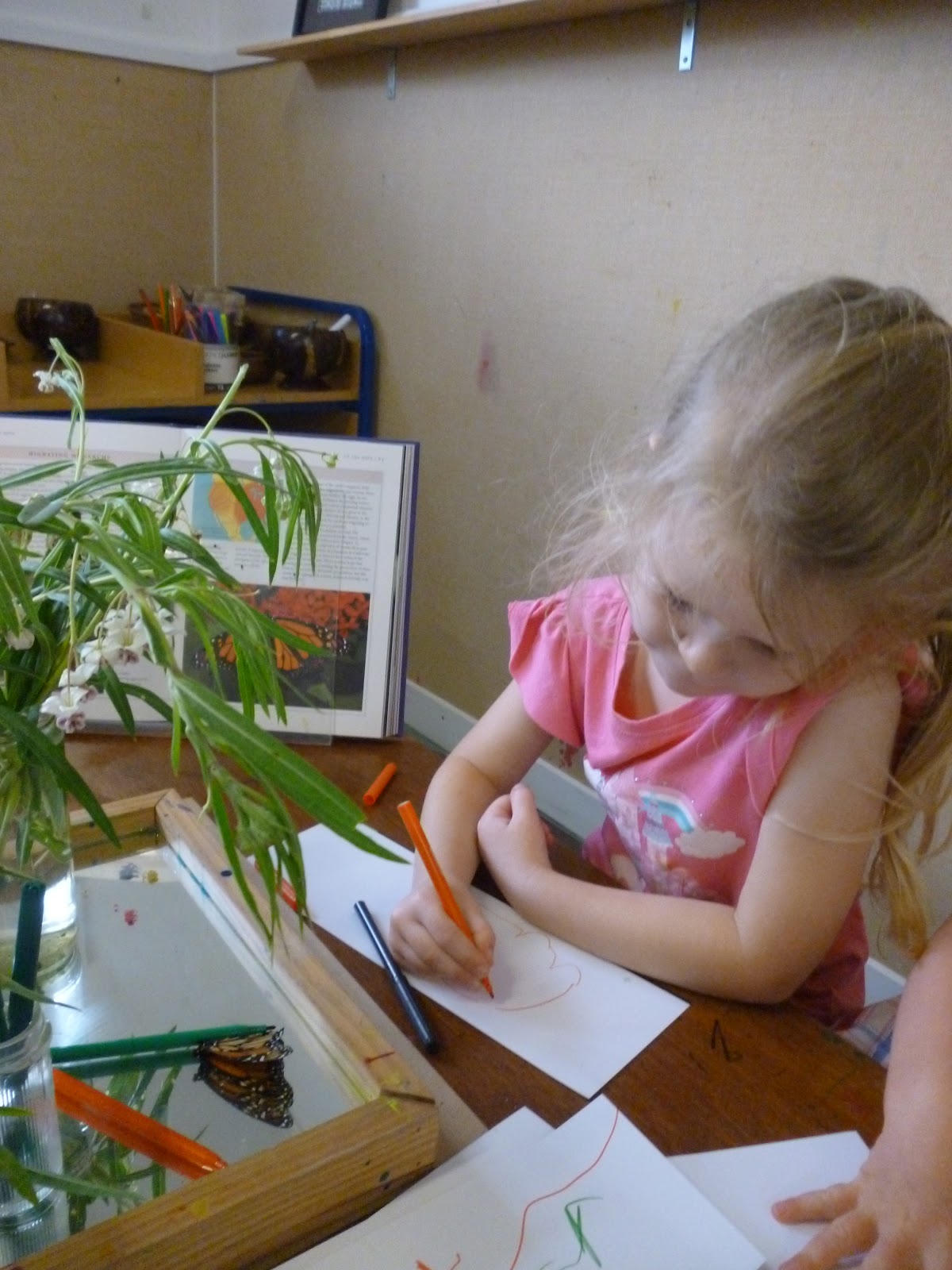The season is upon us again when Monarch butterflies lay
hundreds of eggs causing swan plants to be demolished by hungry little
caterpillars. Only this year we have had hardly any caterpillars on our swan
plants. This is due to the fact that wasps are eating the newly hatched
caterpillars for their dinner. So knowing this, some of the children made it
their mission to rescue baby caterpillars from these evil wasps.
In one morning Alex found ten babies and brought them
indoors for their own safety. This created a huge amount of interest amongst
the children as they began to observe the caterpillars grow. Next to where the caterpillars were placed was some research books about Monarch butterfly, as well as pens and paper which encouraged
children engage in observational drawing. This created lots of dialogue
where the children discussed their ideas and knowledge about the wonderful
Monarch butterfly and their life cycle.
Pesiki: “They go to
sleep and the next day they wake up and change into a small butterfly.”
Alex: “No! They sleep for 1 day, 2 days, 3 days, 4 days, 5 days and then they wake up and turn into butterflies.”
Pesiki: “Oh. You know that the caterpillars eat these leaves but we can’t.”
Alex: “Yeah, because they are poisonous to us, aye.”
Pesiki: “Yeah, they can eat the leaves and get big and fat. If the caterpillars don’t eat the leaves then they will get skinny.”
Alex: “No! They sleep for 1 day, 2 days, 3 days, 4 days, 5 days and then they wake up and turn into butterflies.”
Pesiki: “Oh. You know that the caterpillars eat these leaves but we can’t.”
Alex: “Yeah, because they are poisonous to us, aye.”
Pesiki: “Yeah, they can eat the leaves and get big and fat. If the caterpillars don’t eat the leaves then they will get skinny.”
For some of these children revisiting the caterpillars has
become a huge part of their day at kindergarten. They have been noting all the
changes, beaming with excitement when they discover that the caterpillars have morphed
into chrysalis’s and waiting with anticipation for the great reveal, when the butterfly
emerges.
Many darwings of the Monarch butterfly life cycle have
been created over the last few weeks. We love to record the children’s ideas,
thoughts and knowledge so we encourage them to tell us about what they have
drawn and what they know about the butterflies. This allows them to be able to
revisit and critique their own work and extend on their own learning. Here are
a few wonderful examples of the children’s voices.
Joseph was discussing the concept of metamorphosis while
drawing his picture.
“They do metamorphosis. It is four things that they change
into. First the caterpillar, then they slide into their cocoon, then they turn
into butterflies. That’s metamorphosis. My Mum taught me about metamorphosis because
she’s really clever and tricky.”
Aimee talked about what she was drawing. Her understanding was that Monarch Butterfly need swan plants to lay there eggs on so her she included a seed pod in her picture.
“These are the eggs. This is the spikey bit (seed pod)… now
a butterfly and they have, look, very long antennae. This is going to be my
baby caterpillar, now I’ll do a bigger caterpillar; this one has bigger
antennae like that one (pointing to a large caterpillar on the plant). Now I have
to do the cocoon.”
Alex has made it his responsibility to be a guardian to the
tiny caterpillars, protecting them from the evil wasps. He brought in some swan plants from his home so that the caterpillars had enough food. He has spent every day
for the last week studying the Monarch butterfly life cycle. Alex has drawn many
pictures to explain his understanding and express his knowledge. He has also made
3D models of the Monarch in all of its life stages; egg, caterpillar, chrysalis
and the butterfly.
I’m drawing caterpillars on the tree and a monarch butterfly landing. Do you want to see its wings? I am drawing it by looking at the picture. I’m going to do something. It hatches into a caterpillar. It’s an egg!
Those black things, the spots on the butterflies wings means it’s a boy. I saw that. That’s how I know. They have to eat lots to get bigger so they don’t get eaten by the wasps. They look like scary monsters to the caterpillars.
That was a caterpillar and now it’s turned into a chrysalis. It’s hanging and now it’s going to be disappearing into a chrysalis. It’s turning green. Look at this chrysalis. Now I have four and I am four. Now this one has hatched out of his egg and it grows and grows and turns green.
This is the Monarch butterflies life;
The butterfly lays an egg on a swan plant.
Then it flies away.
The egg hatches into a caterpillar. It’s tiny.
It gets bigger. It eats lots. It poo’s lots.
The big caterpillar turns into a chrysalis.
It stays in it for 5 weeks.
It turns into a butterfly. It flies away and goes to lay eggs. ”
The butterfly lays an egg on a swan plant.
Then it flies away.
The egg hatches into a caterpillar. It’s tiny.
It gets bigger. It eats lots. It poo’s lots.
The big caterpillar turns into a chrysalis.
It stays in it for 5 weeks.
It turns into a butterfly. It flies away and goes to lay eggs. ”
The Monarch butterfly life cycle creates so much interest and curiosity amongst children. It allows them to explore scientific concepts around metamorphosis and change. This wonderful creature helps immerse children in one of the most intriguing and beautiful processes that the natural world has to offer.
“Children have a natural affinity towards nature. Dirt, water, plants,
and small animals attract and hold children’s attention for hours, days, even a
life time.” (Moore and Wong)















No comments:
Post a Comment